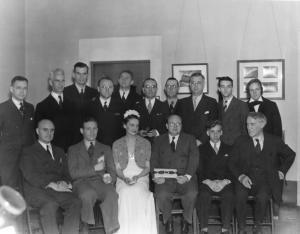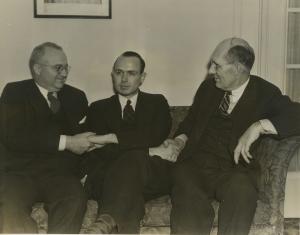 Everyone loves a parade – especially one followed by a banquet. When scientists and politicians met in Washington, D.C., on November 23, 1936, to celebrate the centennial of the U.S. patent system, they listened first to a conventional program of speeches. Then, in the afternoon, Science Service director Watson Davis arranged something different: a “Research Parade” featuring music, films, slide projections, off-stage narration, and a “Maid of Science.”
Everyone loves a parade – especially one followed by a banquet. When scientists and politicians met in Washington, D.C., on November 23, 1936, to celebrate the centennial of the U.S. patent system, they listened first to a conventional program of speeches. Then, in the afternoon, Science Service director Watson Davis arranged something different: a “Research Parade” featuring music, films, slide projections, off-stage narration, and a “Maid of Science.”
“I call upon Drama to come to the aid of Science,” Davis declared as he scattered sheets of paper into the air. “I fling this weighty scientific paper away as a symbol of breaking with the customary.” Prominent engineers and scientists then took the stage to demonstrate their inventions, augmented by some theatrical “rough magic.” Smithsonian Secretary Charles G. Abbot explained how his “solar cooker” could harness the sun’s energy. RCA scientist Vladimir K. Zworykin displayed his iconoscope, which made it possible to “see the invisible.” And in the final segment, a local actress, wearing a white acetate crepe evening dress and a Celanese velvet wrap, carried “a silk purse made from sows’ ears.” This artifact of scientific history had been created in 1921 by chemist Arthur D. Little. Animal parts had been rendered into a gelatin, spun into threads, and then dyed and knitted into a handbag.

 The participants reassembled that evening for a “Patented Dinner” at the Mayflower Hotel. As 1,100 guests entered the candlelit hall, General Motors executive Charles F. (“Boss”) Kettering waved his hand before a photoelectric cell and the room was flooded with 60,000 watts of incandescent light. The banquet included such “edibles, digestibles, comestibles, beverages and suggestables” as irradiated milk and fresh-frozen lobster and lima beans. Party favors included Bakelite cigar holders, and an elaborate menu listed patent numbers for everything on the table, including “Ye Olde ‘Pat’ Pending” Sherry. The planning committee had actually met a few weeks earlier to taste-test the items to be served (and to grab some advance publicity). Those diners “ate and drank boldly,” wrote the Washington Post, but showed “signs of a greenish pallor” when, after drinking a cocktail, they were told the concoction had been patented for a non-culinary purpose. “Friedrich Wilhelm Emil Müller’s Hair-Tonic” (U.S. Patent No. 939,431) contained “40% harmless distilled best corn whiskey, 20% port wine, 25% ripe black currants, 10% water ... and 5% sugar.” As the Post observed, after “another dash of tonic,” the experimental subjects “didn’t seem to care.”
The participants reassembled that evening for a “Patented Dinner” at the Mayflower Hotel. As 1,100 guests entered the candlelit hall, General Motors executive Charles F. (“Boss”) Kettering waved his hand before a photoelectric cell and the room was flooded with 60,000 watts of incandescent light. The banquet included such “edibles, digestibles, comestibles, beverages and suggestables” as irradiated milk and fresh-frozen lobster and lima beans. Party favors included Bakelite cigar holders, and an elaborate menu listed patent numbers for everything on the table, including “Ye Olde ‘Pat’ Pending” Sherry. The planning committee had actually met a few weeks earlier to taste-test the items to be served (and to grab some advance publicity). Those diners “ate and drank boldly,” wrote the Washington Post, but showed “signs of a greenish pallor” when, after drinking a cocktail, they were told the concoction had been patented for a non-culinary purpose. “Friedrich Wilhelm Emil Müller’s Hair-Tonic” (U.S. Patent No. 939,431) contained “40% harmless distilled best corn whiskey, 20% port wine, 25% ripe black currants, 10% water ... and 5% sugar.” As the Post observed, after “another dash of tonic,” the experimental subjects “didn’t seem to care.”
On display at the banquet were a replica of the McCormick reaper and a 1903 Cadillac. An antique gramophone, a new Hammond organ, and a patented “pocket violin” provided background music during the meal. Other entertainment included a radio broadcast from an Eastern Air Lines plane circling above Washington and a phonograph recording of the late Thomas Alva Edison. Western Union transmitted “What hath God wrought” over one of Samuel F. B. Morse’s original telegraph receivers, on loan from Cornell University. Tables were decorated with hybridized (and patented) flowers, including the “Better Times” (red) and “Mrs. Franklin D. Roosevelt” (pale pink) roses. After dinner, the guests toddled to the ballroom for the Patent Office Society’s annual dance.
 Four years later, Kettering presided over another celebration of invention, this time commemorating the 150th anniversary of the signing of the patent law. Once again, Davis helped plan the program and arranged a promotional “test” dinner on April Fool’s Day 1940. The Mayflower Hotel banquet featured more patent-themed foods, such as “telegraph soup” with macaroni “dots and dashes” rather than alphabet letters. This time, the advertised beverage was Joshua T. Smith’s “snake bite cure” (U.S. Patent No. 379,183, granted in 1888) altered to blend whisky and port wine rather than the original patent formula of alcohol, gall of the earth, rattlesnake weed, alum, and tincture of iodine.
Four years later, Kettering presided over another celebration of invention, this time commemorating the 150th anniversary of the signing of the patent law. Once again, Davis helped plan the program and arranged a promotional “test” dinner on April Fool’s Day 1940. The Mayflower Hotel banquet featured more patent-themed foods, such as “telegraph soup” with macaroni “dots and dashes” rather than alphabet letters. This time, the advertised beverage was Joshua T. Smith’s “snake bite cure” (U.S. Patent No. 379,183, granted in 1888) altered to blend whisky and port wine rather than the original patent formula of alcohol, gall of the earth, rattlesnake weed, alum, and tincture of iodine.
By the Spring of 1940, war clouds were spreading over the globe. Davis and his committee organized a week-long “Parade of Inventions” exhibition in the U.S. Department of Commerce auditorium to accompany the banquet. Over 40,000 visitors saw historic artifacts (such as Abraham Lincoln’s handwritten patent application and model), including 300 objects from Smithsonian collections, and consumer products (a razor display included a “Beardoscope,” showing the variety of chin beard growth) but most displays referenced industrial productivity and military potential. Glenn L. Martin Company, for example, provided the nose section from a Model 167-F bomber.
That same year, Watson Davis was at work on his Science Picture Parade. In that book and the exhibit brochure, he had attempted to set an optimistic tone. Science’s parade, however, was heading down a new route. By summer 1940, Kettering, Davis, and other members of the National Inventors Council were tasked with collecting examples of private invention and directing useful ideas toward the impending war effort.
Related Resources
- Record Unit 007091, Science Service, Records, circa 1910-1963, Series 14, National Inventors Council, Smithsonian Institution Archives
- Leo Baekeland Diary, Volume 57, 1936-1937, National Musuem of American History Archives Center, Smithsonian Transcription Center
- "On the Making of Silk Purses from Sows' Ears," 1921, MIT Institute Archives & Special Collections
- "Broadcasting Live from the Sun," Bigger Picture, Smithsonian Institution Archives
Produced by the Smithsonian Institution Archives. For copyright questions, please see the Terms of Use.

Leave a Comment